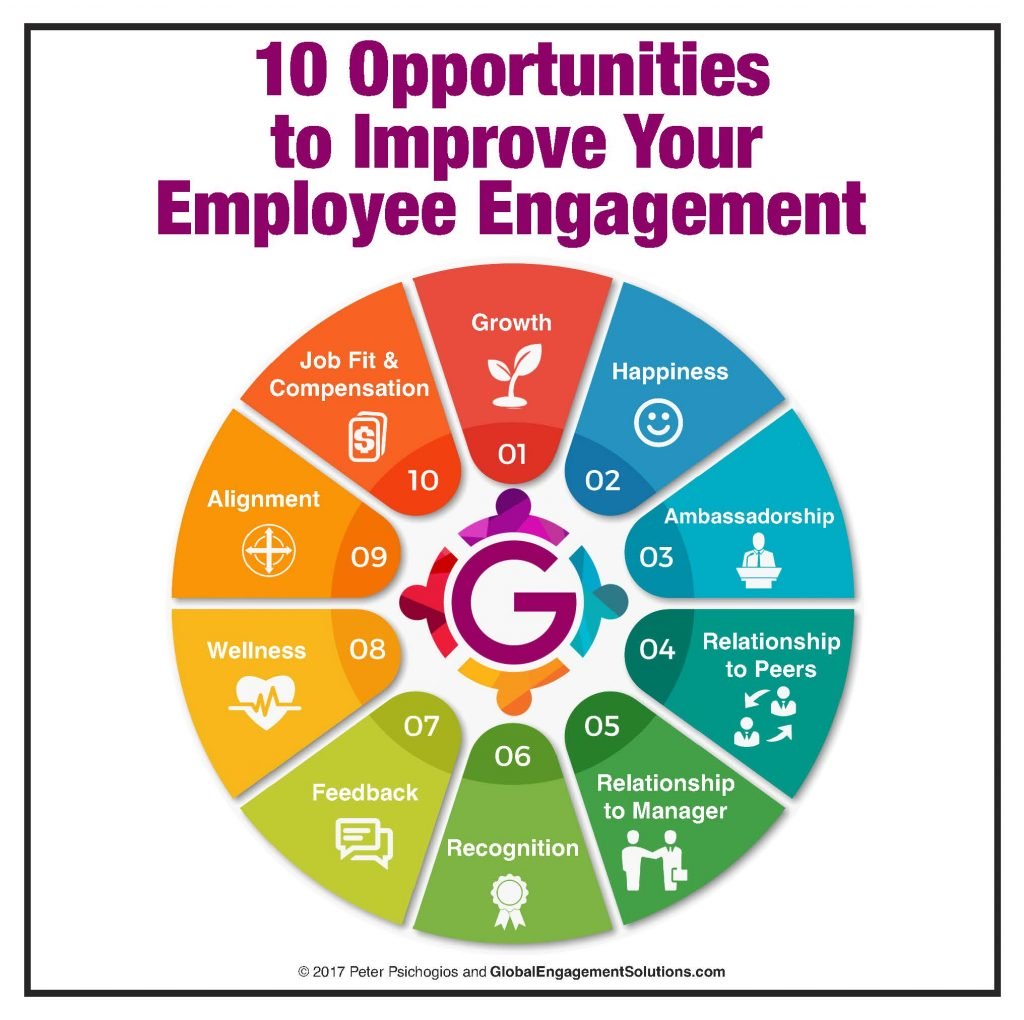10 Opportunities to Improve Your Employee Engagement
By Peter Psichogios

We talk about Employee Engagement so often in the workplace, but many manager and leaders are unsure of how they can really know if their employees are engaged. Our friends at OfficeVibe have derived 10 metrics that are great indicators to whether your employees are really engaged. Luckily with this data Global Engagement Solutions has many opportunities to help you achieve better engagement in your organization.
- Growth - Every employee wants to feel like they have an opportunity to learn and grow in your organization. If you invest in their growth through learning and development you will get their discretionary energy, engagement and loyalty. Find out more about How to Enable Your Employees with Learning.
- Happiness - Happiness can sometimes be a tough measure to gauge. General indicators for happiness at work are if an employee feels like they have autonomy over their work, if they feel supported and not overwhelmed with their workload and if they feel like they have a good work-like balance.
- Ambassadorship - Do you know what stories are being told inside by your employees? The level of ambassadorship is really a measure of your employee’s loyalty and what they say about your company. It's important for your employees to be engaged because the stories being told on the inside, can be felt on the outside by your customers.
- Relationship to Peers - Do your employees have good relationships with one another? It is important to focus on peer to peer relationships in order to keep your internal service cooperation in peak performance. You can also foster great peer to peer relationships with opportunities for peer to peer recognition. For example GES’s Total Recognition platform has an internal social media function so colleagues can create a community of acknowledgement and engagement.
- Relationship to Manager - Leadership is paramount in any organizations. It’s been said that many employees stay (and thrive) not for the organization but for their manager. Are your leaders creating great relationships with their direct reports? Are they providing them with one on one coaching and clear and open communication.
- Recognition- Recognition in the workplace can take on many forms. It can be as simple as a non-monetary Thank You or acknowledgement in front of their peers. It can also include monetary recognition such as bonuses, a salary increase or a Total Recognition program where you can reward employees at every touch point with rewards. These points can be redeemed for things such as merchandise, gift cards, travel and much more. Giving your employees personalized rewards that are unique to what they want is crucial.
- Feedback - Feedback is an important element to your employees growth and happiness. Do your leaders have frequent and open communication with their direct reports? Are they transparent in their expectations and work with employees to help them get there? Feedback and coaching is an important element for engagement because your employees will feel like they are valued in the organization, they will know what they need to do to improve, and they will see that you are dedicated to their growth.
- Wellness- It is easy to tell if you have a culture focused on wellness. You can measure this with many indicators such as overall absenteeism, productivity and employee health. In addition to employee engagement, when you have a culture of wellness you will see many benefits, including lower turnover, increased attraction of new employees, decreased absenteeism, greater productivity, and a decrease in health disorders including lack of sleep, anxiety and obesity.
- Alignment - Whether or not a person is aligned with your organization starts from the very minute they are hired. That’s why it is important to hire employees who are a cultural fit. For example, personalization traits such as friendliness and fun can rarely be trained, so it’s crucial to make sure your new hires are a good fit, or it’s unlikely they will thrive in your environment.
- Job Fit & Compensation- Satisfaction is really an overall indicator of employee engagement. This can include elements such as compensation, work environment, and fit of role for the employee. Some ways you can improve the overall satisfaction of your employees include providing them with fair and competitive salary, offering them flexibility to work remotely or flexible hours, providing them with autonomy and authority to do their role to the best of their ability (i.e. not micromanaging).
When you focus on the indicators of employee engagement that were discussed above such as learning and development, coaching, wellness, cultural alignment and rewards and recognition, plus factor in each individual employees needs and desires, you will have great satisfaction in your organization, which will be felt on the outside by your customers.
If you’re ready to put these principles into action check out our eLearning solutions and get in touch for your free demo today!
Subscribe to P3 Insights
Get relevant employee engagement insights to help you build a thriving workplace culture.
See How You Can Build a Thriving Workplace Culture
Get a Demo
